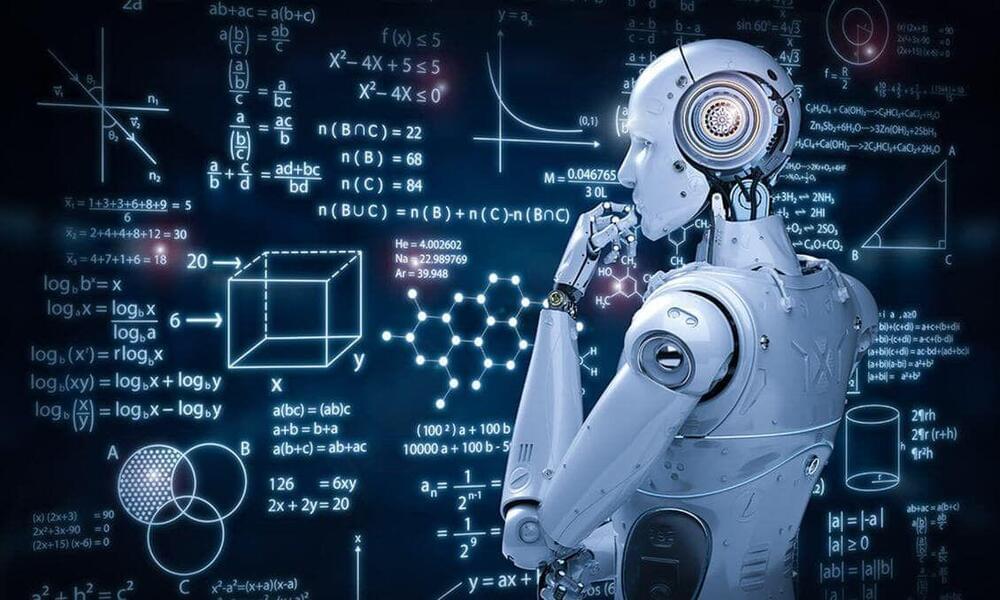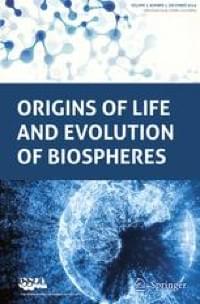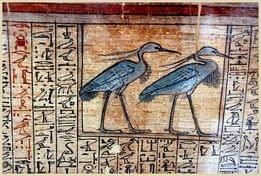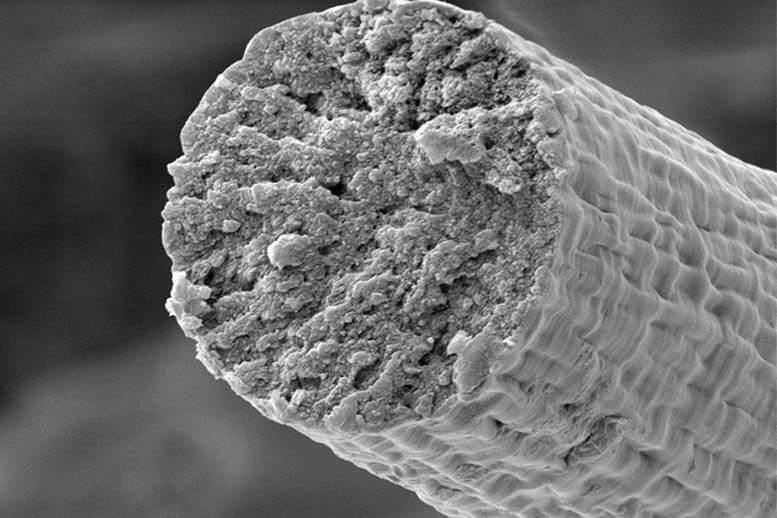Should we be searching for post-biological aliens?



A more general definition of entropy was proposed by Boltzmann (1877) as S = k ln W, where k is Boltzmann’s constant, and W is the number of possible states of a system, in the units J⋅K−1, tying entropy to statistical mechanics. Szilard (1929) suggested that entropy is fundamentally a measure of the information content of a system. Shannon (1948) defined informational entropy as \(S=-\sum_{i}{p}_{i}{log}_{b}{p}_{i}\) where pi is the probability of finding message number i in the defined message space, and b is the base of the logarithm used (typically 2 resulting in units of bits). Landauer (1961) proposed that informational entropy is interconvertible with thermodynamic entropy such that for a computational operation in which 1 bit of information is erased, the amount of thermodynamic entropy generated is at least k ln 2. This prediction has been recently experimentally verified in several independent studies (Bérut et al. 2012; Jun et al. 2014; Hong et al. 2016; Gaudenzi et al. 2018).
The equivalency of thermodynamic and informational entropy suggests that critical points of instability and subsequent self-organization observed in thermodynamic systems may be observable in computational systems as well. Indeed, this agrees with observations in cellular automata (e.g., Langton 1986; 1990) and neural networks (e.g., Wang et al. 1990; Inoue and Kashima 1994), which self-organize to maximize informational entropy production (e.g., Solé and Miramontes 1995). The source of additional information used for self-organization has been identified as bifurcation and deterministic chaos (Langton 1990; Inoue and Kashima 1994; Solé and Miramontes 1995; Bahi et al. 2012) as defined by Devaney (1986). This may provide an explanation for the phenomenon termed emergence, known since classical antiquity (Aristotle, c. 330 BCE) but lacking a satisfactory explanation (refer to Appendix A for discussion on deterministic chaos, and Appendix B for discussion on emergence). It is also in full agreement with extensive observations of deterministic chaos in chemical (e.g., Nicolis 1990; Györgyi and Field 1992), physical (e.g., Maurer and Libchaber 1979; Mandelbrot 1983; Shaw 1984; Barnsley et al. 1988) and biological (e.g., May 1975; Chay et al. 1995; Jia et al. 2012) dissipative structures and systems.
This theoretical framework establishes a deep fundamental connection between cyberneticFootnote 1 and biological systems, and implicitly predicts that as more work is put into cybernetic systems composed of hierarchical dissipative structures, their complexity increases, allowing for more possibilities of coupled feedback and emergence at increasingly higher levels. Such high-level self-organization is routinely exploited in machine learning, where artificial neural networks (ANNs) self-organize in response to inputs from the environment similarly to neurons in the brain (e.g., Lake et al. 2017; Fong et al. 2018). The recent development of a highly organized (low entropy) immutable information carrier, in conjunction with ANN-based artificial intelligence (AI) and distributed computing systems, presents new possibilities for self-organization and emergence.

Quantum sensing is being used to outpace modern sensing processes by applying quantum mechanics to design and engineering. These optimized processes will help beat the current limits in processes like studying magnetic materials or studying biological samples. In short, quantum is the next frontier in sensing technology.
As recently as 2,019 spin defects known as qubits were discovered in 2D materials (hexagonal boron nitride) which could amplify the field of ultrathin quantum sensing. These scientists hit a snag in their discovery which has unleashed a scientific race to resolve the issues. Their sensitivity was limited by their low brightness and the low contrast of their magnetic resonance signal. As recently as two weeks ago on August 9 2021, Nature Physics published an article titled “quantum sensors go flat,” where they highlighted the benefits and also outlined current shortfalls of this new and exciting means of sensing via qubits in 2D materials.
A team of researchers at Purdue took on this challenge of overcoming qubit signal shortcomings in their work to develop ultrathin quantum sensors with 2D materials. Their publication in Nano Letters was published today, September 2 2021, and they have solved some of the critical issues and yielded much better results through experimentation.



Cats have many superior genetic mutations like night vision even immunity to the current pandemic. If we can find the key to their immunity we could find a way to have near super human immunity.
“Getting a better understanding of the cat’s biology and genetic makeup will help us better understand the biology of humans, too,” says Leslie Lyons. (Credit: Lottie/Flickr)
The findings, published in Trends in Genetics, come after decades of genome DNA sequencing by Leslie Lyons, professor of comparative medicine in the University of Missouri College of Veterinary Medicine. Their cat genome assembly is nearly 100% complete.

The game is the ORIGINAL Kabbalah imo. Here is Hymn to the 10 Bau of Amen from “The Slates of Zizyphus“
Awake being rested, May you awake in peace!
May Amen awake in life and peace.
May (name) awake in peace!
[FIRST bA] “bA in his ever-lasting flame“
Horus who is in the Nomes {districts}
Who illumines the Two Lands.
Bull who ejaculates Nun.
Who lives eternally.
In his name of Rah, Every day.
[SECOND bA] “bA in his Left Eye“
The one living of births in his left eye.
Whom everybody loves.
In his effective form of Moon.
God of hearts and minds.
[THIRD bA] “bA of Shu“
It is in allowing throats to breathe, That he spits out wind.
In his name of Amen-who-endures-in all-things.
The Ba of Shu for every God.
[FOURTH bA] “bA of Osiris“
Body of life who creates the “wood-of-life“
Neprii who floods the Two Lands.
Nobody in the circuit of the Two Lands lives without his knowledge.
In his name of Nun the Elder.
[FIFTH bA] “bA of Tefnut“
The b3-ram who is in his Mhn-serpent.
Who illumines by means of his brilliant eyes.
Whose torch-flame encircles him in the earth.
In his name of Res Wedja {Osiris}
God who creates the morning-light.
[SIXTH bA] “bA of the Living Royal Ka“
Horus of the Five Bau.
Living one who lives in Nun.
In his name of Living Royal Ka.
God of the Sunfolk.
[SEVENTH bA] “bA of rw-tsy {Sphinx}“
Lion, Living of face before the Great Temple of Anu.
Who spits out every lion.
In his name of bA of bAu.
God of animals.
[EIGHTH bA] “Human figure, unlabelled“
Horus of the Horus Gods.
Dappled of plumage.
Who lives as falcon gods.
In his name of Horakhty.
God of the recumbent ones.
[NINTH bA] “Living bA, he shines when he comes forth from the nt-waters” {crocodiles}
He who enters into the earth, The srq-lake in his innards.
In his name of Ba of those-in-the-water.
God of fish.
[TENTH bA] “Living bA […] the Gods“
{bA of the chthonic creatures}
He who lives as a scarab-beetle.
Who flies to that which the HeH-Gods support.
Who lives in his name of Nehebkau.
God of those in their tombs.
https://www.academia.edu/240044/Adoration_of_the_Ram_Five_Hymns_to_Amun-Re_from_Hibis_Temple_2006_?
Dedicated to Darius I, the Invocation Hymn to Amen-Ra in his ten-foldness incorporates all of the cosmos, from the very highest (the Sun) down to the smallest and final 10th bA, (the chthonic underground realm of worms and sub-terrestrial microbes).
My book (Khemetic Chess/ Hypermodern Magick
Mandrake Press) claims that elements from New Kingdom ritual Zenet, plus the Invocation Hymn to the 10 bau of Amen-Ra, constitutes the origins of what came to be ‘Kabbalah’. Darius I is dedicated in Hibis temple and helped to build the Second Jerusalem Temple. He facilitated transmission of this 10 bau/ emanations of deity concept from Hibis and Khem into mystical Judaism. More in Zenet 1 also, and FB senet group.

Program aims to fortify supply chain by utilizing bioengineering approaches to facilitate REE separation and purification.
Rare Earth Elements (REEs) are a group of 17 similar metals that are critical material components of many DoD systems, including lasers, precision-guided weapons, magnets for motors, and other devices.1 Although the U.S. has adequate domestic REE resources, its supply chain is vulnerable due to dependence on foreign entities for separation and purification of these elements. “Biomining,” an approach that uses microbes to extract or separate target metals like gold or copper from a variety of sources is not yet useful for REEs because of poor specificity and selectivity of the microbes for REEs. The Environmental Microbes as a BioEngineering Resource (EMBER) program aims to leverage advances in microbial and biomolecular engineering to develop a scalable bio-based separation and purification strategy for REEs using under-developed domestic sources.
“The EMBER program will aim to fill a critical DoD supply chain gap” stated Dr. Linda Chrisey, EMBER program manager. “The program will target the development of bioengineered organisms/biomolecular approaches for REE purification, then translate these to practical biomining modules (e.g., biosorbent, biofiltration) that can be integrated with domestic REE sources.”
The four-year program will address two Technical Areas (TAs) and be divided into three phases. The goal of TA1, “Bioengineering for REE Utilization,” is to establish a platform for engineering organisms and/or biomolecules to enable the binding of REEs under harsh conditions. TA2, “REE Biomining” will focus on developing and testing a biomining workflow to purify individual REEs from actual source materials. Teams must propose to both TAs to develop comprehensive, enduring solutions.


No animals were harmed in the production of the synthetic muscle fibers, which are tougher than Kevlar.
Would you wear clothing made of muscle fibers? Use them to tie your shoes or even wear them as a belt? It may sound a bit odd, but if those fibers could endure more energy before breaking than cotton, silk, nylon, or even Kevlar, then why not?
Don’t worry, this muscle could be produced without harming a single animal.